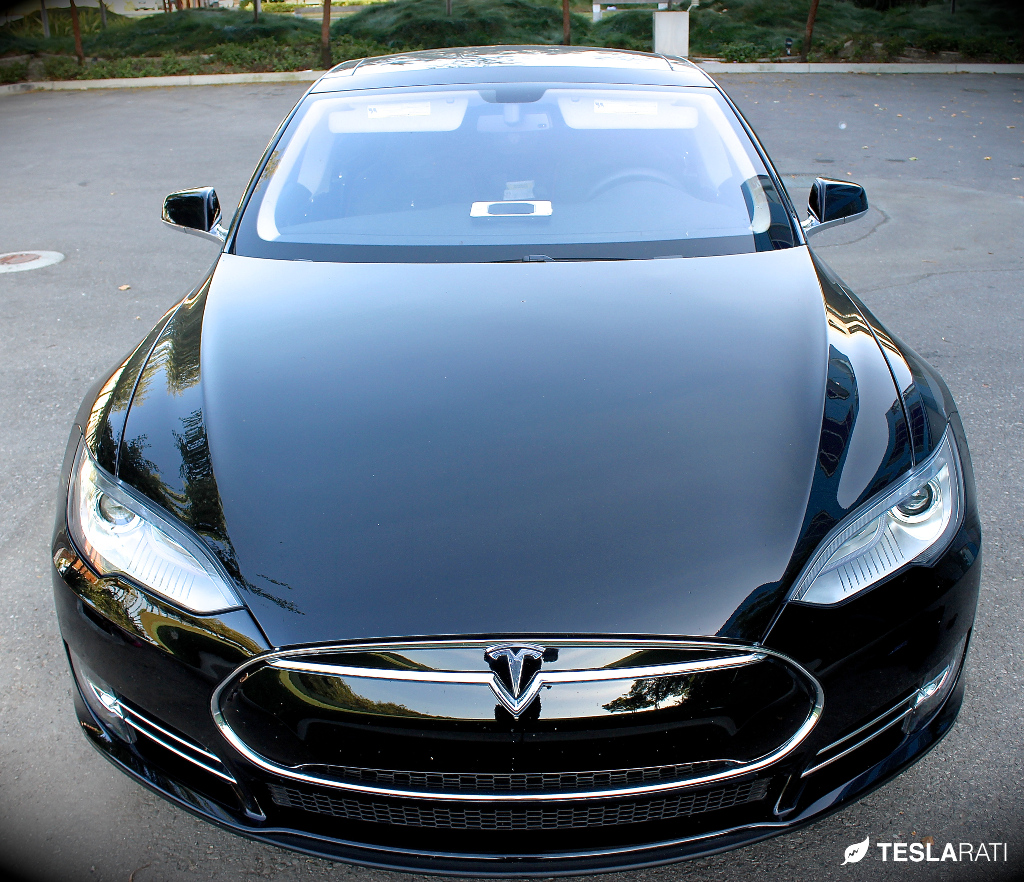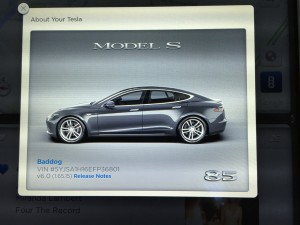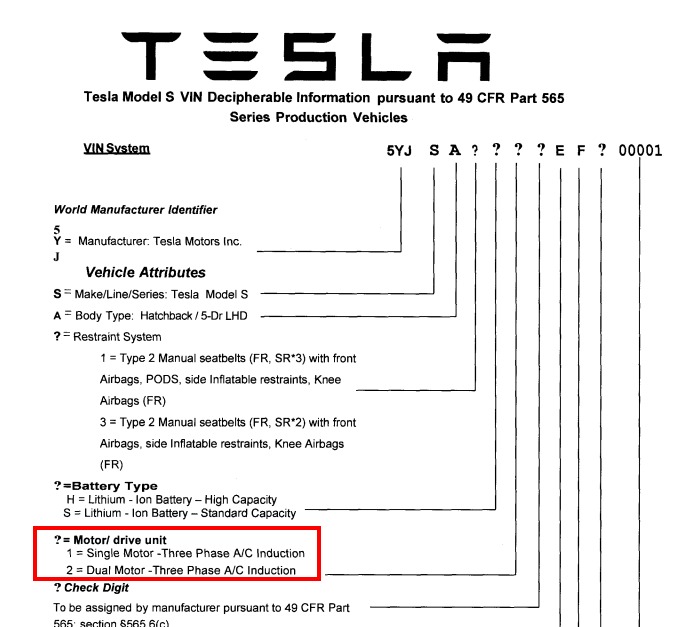

News
How to Decode Your Tesla Model S VIN
 With the Model X delivery around the corner, the recent announcement of the Model 3 and the much anticipated unveiling of the “D”, we thought it would be fun decode the Model S Vehicle Identification Number (VIN) and take a wild guess on how future VINs may look like.
With the Model X delivery around the corner, the recent announcement of the Model 3 and the much anticipated unveiling of the “D”, we thought it would be fun decode the Model S Vehicle Identification Number (VIN) and take a wild guess on how future VINs may look like.
Finding your VIN
The VIN is a 17 character alphanumeric fingerprint to your vehicle often found on the lower left corner of your dashboard and against the windshield. Law requires that it be placed in a visibly prominent spot on the car and for that reason it’s not a secret code, dispelling the myth that your VIN is a confidential identifier. I’d hate to break it to you but your VIN is not a secret.
The Tesla Model S VIN can also be viewed by pressing the Tesla logo at the top of the 17″ display. The VIN is required by DMV and also when registering your vehicle with the insurance company because it provides a wealth of information about your vehicle.
Decoding the Tesla Model S VIN
Referencing Tesla’s filing with the National Highway Traffic Safety Administration (NHTSA), here’s how we can decode the Model S VIN.
The first digit in the VIN indicates the vehicle’s country of origin which can also be its assembly location. Referencing CarFax we know that 5 represents the country code for the USA. The second character, Y, is for Tesla Motors as the Manufacturer. The third character, J, represents the vehicle type. Things start to become even more detailed as we start moving into the Vehicle Descriptor Section.
The make of vehicle is the first character within the Vehicle Descriptor Section. S is for the Model S, R for the Roadster and following this pattern we should expect to see codes of X, 3, and possibly D down the road.
The next character, A, is the body type and represents a 5 door hatchback with left hand drive. Right hand drive Model S’ use the letter B. The restraint system has had a few different variations but a 1 represents Manual Type 2 USA Seat Belts while Dual Front Airbags, Front/Rear Side Airbags, Knee Airbags etc. utilize their own set of codes.
The battery type, H, is for the 85kWh battery, and S is for the 60kWh battery. The final digit indicates the number of drive units (motors). This will be 2 for the Model X. Based on this Tesla Motors NHTSA VIN filing, it’s almost certain that a dual motor Model S will soon be announced. We’ll expect to see a 2 in the VIN of the Model S “D”.

The next code labeled Check Digit is just a way for agencies to verify the VIN through a mathematical algorithm. The year is a code with E representing 2014, F for 2015 etc.
The assembly plant is F which stands for Fremont, CA and there appear to be other plant codes they’ve used in the past. As Tesla starts assembly in other countries we’ll expect to see new codes here.
The first character of the production number indicates the stage of production with a few interesting codes:
 Mine is a P for production level. The final 5 digits are a unique serial number. People often abbreviate their VIN with just the production number, so P36801 in my example.
Mine is a P for production level. The final 5 digits are a unique serial number. People often abbreviate their VIN with just the production number, so P36801 in my example.
The Tesla Motors VIN is constantly evolving as the electric carmaker continues to expand their lineup and into different markets. Don’t for one second think it’s just simple letter or number because in reality each one represents exciting new changes for Tesla Motors.
What does your VIN say about your car? Let us know in the comments below.

Elon Musk
Elon Musk’s X will start using a Tesla-like software update strategy
The initiative seems designed to accelerate updates to the social media platform, while maintaining maximum transparency.

Elon Musk’s social media platform X will adopt a Tesla-esque approach to software updates for its algorithm.
The initiative seems designed to accelerate updates to the social media platform, while maintaining maximum transparency.
X’s updates to its updates
As per Musk in a post on X, the social media company will be making a new algorithm to determine what organic and advertising posts are recommended to users. These updates would then be repeated every four weeks.
“We will make the new 𝕏 algorithm, including all code used to determine what organic and advertising posts are recommended to users, open source in 7 days. This will be repeated every 4 weeks, with comprehensive developer notes, to help you understand what changed,” Musk wrote in his post.
The initiative somewhat mirrors Tesla’s over-the-air update model, where vehicle software is regularly refined and pushed to users with detailed release notes. This should allow users to better understand the details of X’s every update and foster a healthy feedback loop for the social media platform.
xAI and X
X, formerly Twitter, has been acquired by Elon Musk’s artificial intelligence startup, xAI last year. Since then, xAI has seen a rapid rise in valuation. Following the company’s the company’s upsized $20 billion Series E funding round, estimates now suggest that xAI is worth tens about $230 to $235 billion. That’s several times larger than Tesla when Elon Musk received his controversial 2018 CEO Performance Award.
As per xAI, the Series E funding round attracted a diverse group of investors, including Valor Equity Partners, Stepstone Group, Fidelity Management & Research Company, Qatar Investment Authority, MGX, and Baron Capital Group, among others. Strategic partners NVIDIA and Cisco Investments also continued support for building the world’s largest GPU clusters.
News
Tesla FSD Supervised wins MotorTrend’s Best Driver Assistance Award
The decision marks a notable reversal for the publication from prior years, with judges citing major real-world improvements that pushed Tesla’s latest FSD software ahead of every competing ADAS system.

Tesla’s Full Self-Driving (Supervised) system has been named the best driver-assistance technology on the market, earning top honors at the 2026 MotorTrend Best Tech Awards.
The decision marks a notable reversal for the publication from prior years, with judges citing major real-world improvements that pushed Tesla’s latest FSD software ahead of every competing ADAS system. And it wasn’t even close.
MotorTrend reverses course
MotorTrend awarded Tesla FSD (Supervised) its 2026 Best Tech Driver Assistance title after extensive testing of the latest v14 software. The publication acknowledged that it had previously criticized earlier versions of FSD for erratic behavior and near-miss incidents, ultimately favoring rivals such as GM’s Super Cruise in earlier evaluations.
According to MotorTrend, the newest iteration of FSD resolved many of those shortcomings. Testers said v14 showed far smoother behavior in complex urban scenarios, including unprotected left turns, traffic circles, emergency vehicles, and dense city streets. While the system still requires constant driver supervision, judges concluded that no other advanced driver-assistance system currently matches its breadth of capability.
Unlike rival systems that rely on combinations of cameras, radar, lidar, and mapped highways, Tesla’s FSD operates using a camera-only approach and is capable of driving on city streets, rural roads, and freeways. MotorTrend stated that pure utility, the ability to handle nearly all road types, ultimately separated FSD from competitors like Ford BlueCruise, GM Super Cruise, and BMW’s Highway Assistant.
High cost and high capability
MotorTrend also addressed FSD’s pricing, which remains significantly higher than rival systems. Tesla currently charges $8,000 for a one-time purchase or $99 per month for a subscription, compared with far lower upfront and subscription costs from other automakers. The publication noted that the premium is justified given FSD’s unmatched scope and continuous software evolution.
Safety remained a central focus of the evaluation. While testers reported collision-free operation over thousands of miles, they noted ongoing concerns around FSD’s configurable driving modes, including options that allow aggressive driving and speeds beyond posted limits. MotorTrend emphasized that, like all Level 2 systems, FSD still depends on a fully attentive human driver at all times.
Despite those caveats, the publication concluded that Tesla’s rapid software progress fundamentally reshaped the competitive landscape. For drivers seeking the most capable hands-on driver-assistance system available today, MotorTrend concluded Tesla FSD (Supervised) now stands alone at the top.
News
Elon Musk’s Grokipedia surges to 5.6M articles, almost 79% of English Wikipedia
The explosive growth marks a major milestone for the AI-powered online encyclopedia, which was launched by Elon Musk’s xAI just months ago.

Elon Musk’s Grokipedia has grown to an impressive 5,615,201 articles as of today, closing in on 79% of the English Wikipedia’s current total of 7,119,376 articles.
The explosive growth marks a major milestone for the AI-powered online encyclopedia, which was launched by Elon Musk’s xAI just months ago. Needless to say, it would only be a matter of time before Grokipedia exceeds English Wikipedia in sheer volume.
Grokipedia’s rapid growth
xAI’s vision for Grokipedia emphasizes neutrality, while Grok’s reasoning capabilities allow for fast drafting and fact-checking. When Elon Musk announced the initiative in late September 2025, he noted that Grokipedia would be an improvement to Wikipedia because it would be designed to avoid bias.
At the time, Musk noted that Grokipedia “is a necessary step towards the xAI goal of understanding the Universe.”
Grokipedia was launched in late October, and while xAI was careful to list it only as Version 0.1 at the time, the online encyclopedia immediately earned praise. Wikipedia co-founder Larry Sanger highlighted the project’s innovative approach, noting how it leverages AI to fill knowledge gaps and enable rapid updates. Netizens also observed how Grokipedia tends to present articles in a more objective manner compared to Wikipedia, which is edited by humans.
Elon Musk’s ambitious plans
With 5,615,201 total articles, Grokipedia has now grown to almost 79% of English Wikipedia’s article base. This is incredibly quick, though Grokipedia remains text-only for now. xAI, for its part, has now updated the online encyclopedia’s iteration to v0.2.
Elon Musk has shared bold ideas for Grokipedia, including sending a record of the entire knowledge base to space as part of xAI’s mission to preserve and expand human understanding. At some point, Musk stated that Grokipedia will be renamed to Encyclopedia Galactica, and it will be sent to the cosmos.
“When Grokipedia is good enough (long way to go), we will change the name to Encyclopedia Galactica. It will be an open source distillation of all knowledge, including audio, images and video. Join xAI to help build the sci-fi version of the Library of Alexandria!” Musk wrote, adding in a later post that “Copies will be etched in stone and sent to the Moon, Mars and beyond. This time, it will not be lost.”










